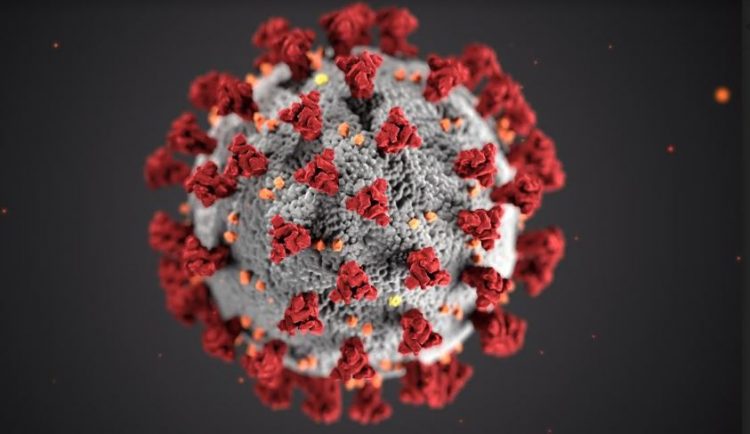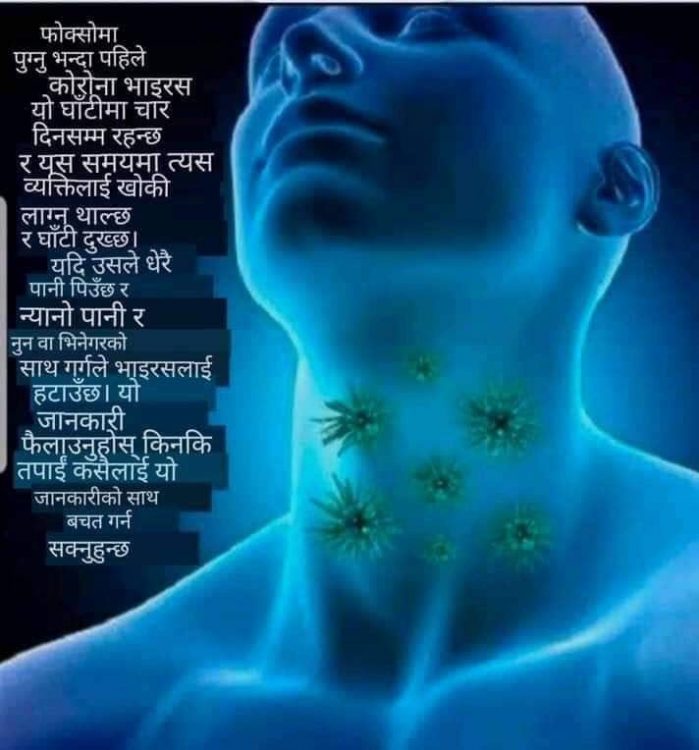COVID-19: What’s circulating on social media and what are the facts?
Injina Panthi / March 20, 2020

A computer rendering of the surface of SARS-CoV-2, the virus strain that causes COVID-19. Photo Courtesy: CDC
Nepal government has introduced emergency measures such as closures of schools and colleges, imposed a ban on gathering of over 25 people and arrival restrictions for passengers from Europe, the Middle East, Gulf countries, Malaysia, Turkey, South Korea and Japan to prevent the possible spread of COVID-19. Misinformation and false claims about the pandemic, however, continue to spread especially through the social media. We have examined several such claims being circulated among the users of social media in Nepal.
Does gargling with warm water with salt or vinegar cure COVID-19?
A meme circulating on Facebook and other social media platforms claims that gargling with warm water mixed with salt or vinegar can eliminate COVID-19. It claims that after the virus reaches the throat, it remains there for four days and causes coughing and throat pain.

This meme circulating on social media in Nepal claims that drinking plenty of water, or gargling with warm water mixed with salt or vinegar removes the coronavirus from the throat.
While Nepalis have traditionally used the solution as domestic remedy for throat pain and coughing, there’s no evidence that it cures the coronavirus. According to the US-based Centers for Disease Control and Prevention, gargling with warmed water mixed with salt/vinegar helps soothe a sore throat, but there’s no proof that it eliminates coronavirus.
Does rinsing your nose with saline water help prevent COVID-19?
It’s a misleading claim. It’s true that it can help people recover from common cold, but it’s not a cure for the coronavirus. Debunking the myth, the World Health Organization (WHO) has said: “There is no evidence that regularly rinsing the nose with saline has protected people from infection with the new coronavirus.”
Can COVID-19 coronavirus survive on the surface of iron for 12 hours?
A YouTube channel called Official Khabar posted a video claiming that coronavirus can survive for 12 hours on the surface of iron. Though other tips the video has offered appeared to be accurate, this one is misleading.
According to a research paper authored by scientists from the National Institute of Health and published in New England Journal of Medicine, the virus could be detected in aerosols and on surfaces ranging from a few hours to several days. “We found that viable virus could be detected in aerosols up to 3 hours post aerosolization, up to 4 hours on copper, up to 24 hours on cardboard and up to 2-3 days on plastic and stainless steel,” the report said.
Will warm temperature help reduce the spread of the coronavirus?
With the end of winter, the temperature is rising across Nepal. Claims that the rise of temperature above 30 degrees Celsius would help reduce the virus are being circulated on social media.
But this claim is unsubstantiated. “Because the impact of influenza reduces with the onset of summer, many people seem to believe that it will help reduce the novel coronavirus from spreading during summer. As its name suggests, this is a new virus and we don’t have any evidence to support such conclusion,” Pushpa Mani Kharal, a medical doctor, told South Asia Check.
What latest researches say about COVID-19?
Latest scientific researches on coronavirus have pointed that one third of the infections of the disease were spread by people who did not demonstrate any symptoms. One research says that people infected with the disease may not show symptoms in the initial state. That’s why experts have recommended social distancing and maintaining a distance of six feet from other people.
This material is copyrighted but may be used for any purpose by giving due credit to southasiacheck.org.
Comments
Latest Stories
- In Public Interest Covid-19 cases are low, but that’s not an excuse to avoid vaccination
- In Public Interest What is BF.7, the sub-variant that has the world by its grip?
- In Public Interest Threat of a new Covid-19 wave looms large amid vaccine shortage in Nepal
- In Public Interest As cases decline, Covid-19 test centres in Kathmandu are desolate lot
- In Public Interest Dengue test fee disparity has patients wondering if they’re being cheated
- In Public Interest As dengue rages on, confusion galore about what it is and what its symptoms are. Here’s what you need to know
In Public Interest
 Covid-19 cases are low, but that’s not an excuse to avoid vaccination
The Pfizer-BioNTech bivalent vaccines authorised by the Nepal Government provide better protection a...
Read More
Covid-19 cases are low, but that’s not an excuse to avoid vaccination
The Pfizer-BioNTech bivalent vaccines authorised by the Nepal Government provide better protection a...
Read More
- What is BF.7, the sub-variant that has the world by its grip?
- Threat of a new Covid-19 wave looms large amid vaccine shortage in Nepal
- As cases decline, Covid-19 test centres in Kathmandu are desolate lot
- Dengue test fee disparity has patients wondering if they’re being cheated
- As dengue rages on, confusion galore about what it is and what its symptoms are. Here’s what you need to know